Hayward Executive Airport (HWD)
Hayward Executive (HWD) is a small, primarily general, and corporate aviation airport located in the city of Hayward, California. Located on the east side of the San Francisco Bay, it is just 5 miles southeast of the larger Oakland International Airport (OAK). GA services are located on the north and south sides of the parallel RWYs. View a printable Pilot Handbook of the HWD information found on this Web page.
Know Before You Go
HWD TWR Hours of Operation 0700L-2100L
Administrative Office Open 0800L to 1700L M-F
Business Phone 510-785-5248
The airspace at HWD is Class D. (Refer to Sectional Chart)
The airport configuration consists of a set of closely spaced parallel RWYs with staggered thresholds labeled RWY 10L/28R and RWY 10R/28L.
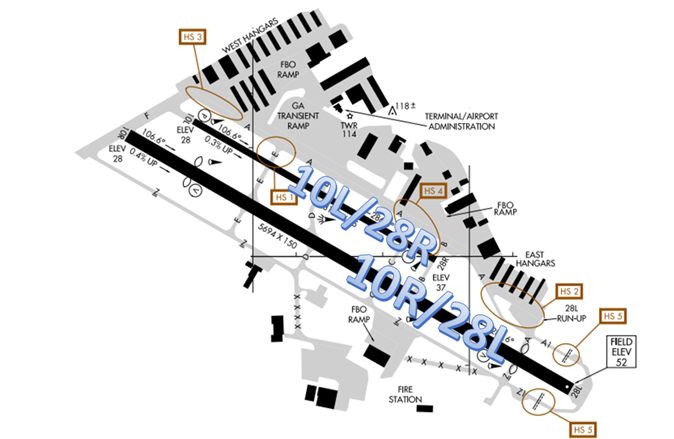
Below find various HWD-specific information and things to be aware of, as well as general information to inform your preflight planning. This will be reviewed quarterly and updated as needed. This information is to supplement the From the Flight Deck Videos that are produced by the FAA Runway Safety Group. Here you will also find information provided by the local air traffic controllers at the airport where you intend to fly. The information is subject to change. Not for navigation or legal* pre-flight action. Always refer to official pre-flight materials such as, but not limited to, NOTAMs, airport diagrams, VFR charts and airport construction notices for the latest airport-specific details.
Hot Spots
HS 1: Aircraft approaching TWY A from the ramp sometimes fail to turn onto TWY A, proceeding onto TWY E and ultimately RWY 10L/28R. Aircraft exiting RWY 10L/28R sometimes fail to contact GND prior to taxiing to parking.
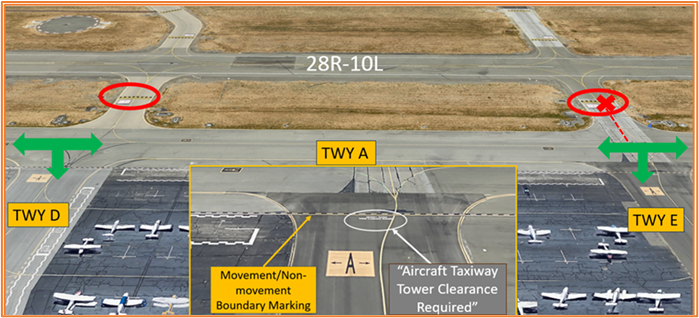
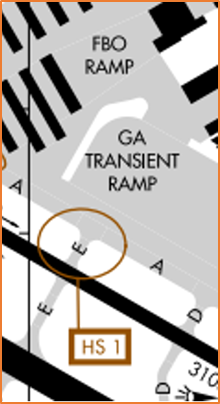
- There are three connector TWYs (C, D, E) that provide direct access to RWY 10L/28R from TWY A in this area. TWYs D and E bound the transient ramp.
- These connector TWYs have Hold Short Position markings and signage that clearly identify the RWY.
- Movement Area boundary markings and surface-painted TWY location markings are present on the ramp approaching TWY A.
- Additionally, pilots exiting RWY 10L/28R and taxiing to the ramp must stop short of TWY A and contact Ground Control for further taxi instructions.
- If you are unsure of your clearance or position, ask the TWR.
HS 2: Area not visible from ATCT.
HS 3: Area not visible from ATCT. Aircraft exiting RWY 10L/28R sometimes fail to contact GC prior to taxiing to parking.
HS 4: Area not visible from ATCT.
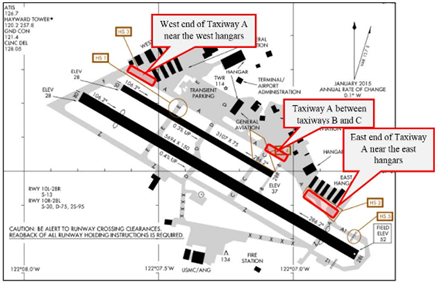
- Due to permanent obstructions to visibility, TWR is unable to provide air traffic services in the following areas:
- At the west end of TWY A, near the west hangers.
- On TWY A between TWYs B and C.
- At the east end of TWY A, near the east hangars.
- Aircraft and vehicle operators should exercise extreme caution when using these areas, Pilots/operators may call Hayward Tower at (510) 785-5248 with any questions or comments concerning these areas,
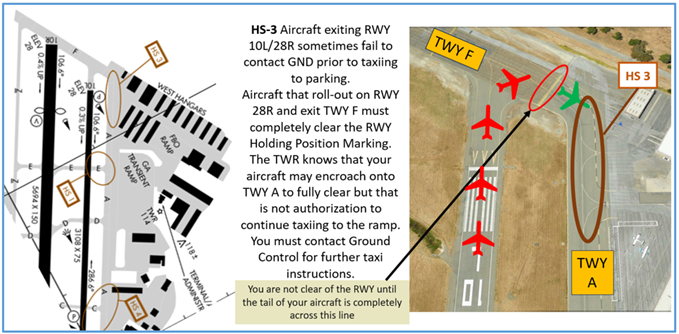
HS 5: RWY 28L hold bars on TWY A1 and TWY Z1 are at non-typical location. Pilots sometimes pass the hold bar without authorization.
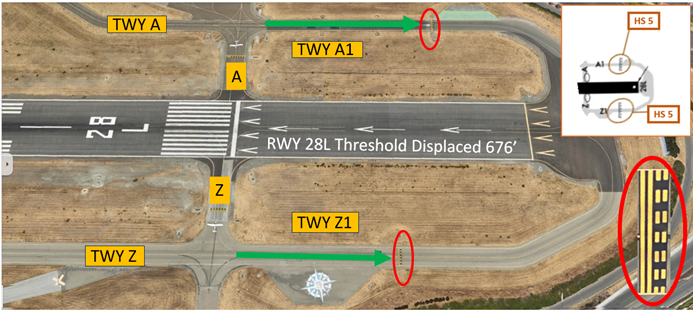
- Pilots taxiing for a RWY 28L full-length departure sometimes taxi past the RWY Holding Position Markings and Signage on TWYs A1 and Z1 without clearance and enter the RWY 28L Runway Safety Area (RSA).
- As with all hold short markings, pilots must hold short of RWY 28L at these locations until they are given a RWY 28L takeoff clearance or RWY 28L Line Up and Wait (LUAW) instruction.
- Pilots should review the taxi clearance before starting to taxi. Actively scanning to locate and identify RWY signs, markings, and lighting and deferring all heads down activities until holding short at the appropriate location will help eliminate these errors.
Wrong Surface Landing Risk
- Wrong Surface Landing risk exists with parallel and offset RWYs with staggered thresholds. This risk increases when TWYs parallel RWYs. Pilots sometimes confuse RWYs 28L/R.
- RWY 28L has precision markings, a displaced threshold, and is twice as wide and over 2500’ longer than RWY 28R.
- Pilots having expectation bias or lining up with the first runway they see can lead to wrong surface landings.
- When possible, back up all visual approaches with an instrument approach.
- RWY Markings are WHITE. Markings on Surfaces not used for Takeoff/Landing like Taxiway Markings, Chevrons, RWY Shoulder and RWY Turn-on Markings etc., are YELLOW.
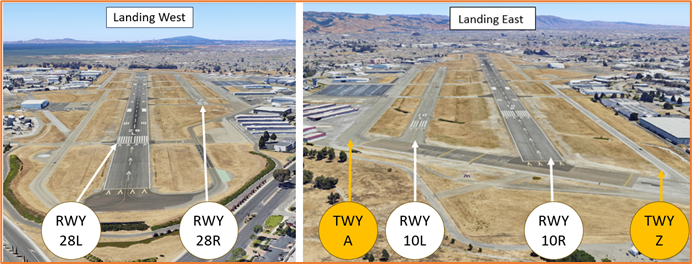
Wrong Airport Landing Risk
- The RWY configuration at HWD is similar to OAK (six miles northwest) and this has led to wrong airport alignment issues.
- During pre-flight planning, check the sectional chart for airports in close proximity and charted reporting points.
- Use navigational aids such as GPS, localizers, or VOR radials to positively identify the airport.
- View the From the Flight Deck-Wrong Airport Landings video for more information and mitigation strategies.
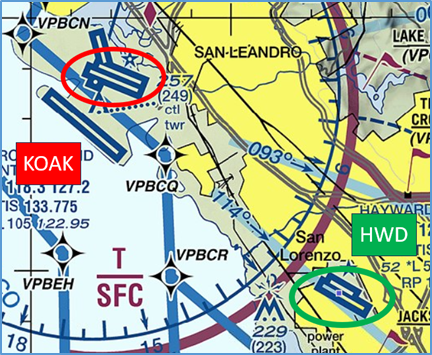
General
- Read back ALL hold short instructions with RWY and callsign.
- Pilots should familiarize themselves with the noise-abatement procedures found on the City of Hayward website: Aircraft noise management | City of Hayward - Official website (hayward-ca.gov).
Traffic Patterns
- HWD traffic pattern altitudes are 650’ for RWY 10R/28L and 850’ for RWY 10L/28R for all aircraft.
- Avoid turning an early left crosswind off RWY 28L/R before the departure end without prior coordination with the tower, as there are often helicopters doing hover work and patterns to Spot Charlie off the left side of RWY 28L on TWY Z.
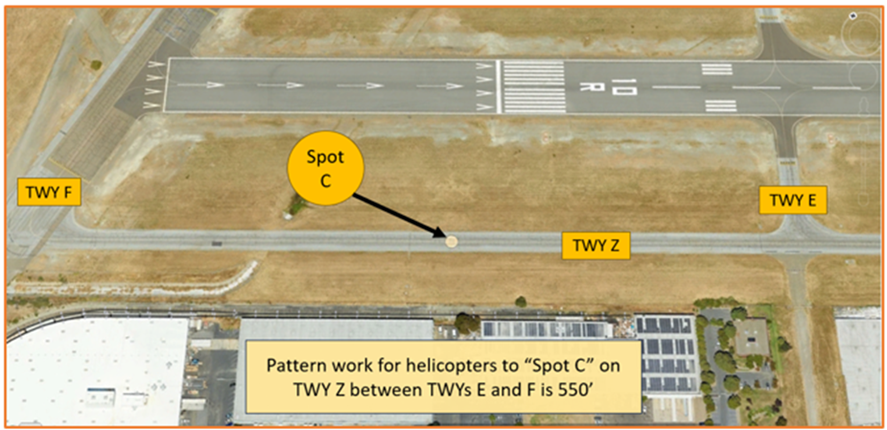
- RWY 28L is generally the default RWY for pattern work. The traffic pattern is considered full for most controllers if three aircraft are in the pattern for RWY 28L and one aircraft is in the pattern for RWY 28R. Additional aircraft requesting pattern work may be denied/delayed.
- When conducting pattern work, use caution for OAK arrivals overhead. Be vigilant when turning crosswind for RWY 28L, as your next turn downwind may put you opposite direction and underneath OAK RWY 30 arrivals.
- Please advise TWR if you intend on making a stop-and-go (and keep the “stop” as brief as possible!). While it is included in the option clearances, the “stop” for aircraft tends to vary, and we appreciate being able to plan some extra space behind stopping aircraft.
- Pattern work is not allowed when the TWR is closed and on Sundays and Holidays before 1000L.
Ground Control
- Clearance Delivery and Ground Control are frequently combined. Pilots calling for clearance on 128.05 may be asked to change to frequency 121.4 to consolidate calls.
- We would appreciate it if aircraft calling for taxi are ready to move. The area further back behind the APP ramp (referred to as “Flying Vikings”, “Hayward Flight”, “Suburban”, “behind the Hayward Hangars”, etc.) often seems to take aircraft a while to taxi out from. As much of this area is not in sight of the TWR, do not unnecessarily delay your taxi out from this area, as other aircraft are often held short of the ramp on TWY A, waiting on you to exit.
- There are three primary run-up areas, all of which are in the Movement Area: 28L Run-up, 28R Run-up, 10L Run-up.

Takeoff/Departure
- Pilots should familiarize themselves with the standard departure instructions that may be issued at HWD off of RWY 28L/R:
- Left downwind departures should maintain at or below 1,000’ until HWY 92.
- Left crosswind departures should maintain at or below 1,000’ until the shoreline.
- Left 270 departures should maintain at or below 1,000’ until overhead midfield.
- Right crosswind departures should fly east of the Three Crosses and maintain below 1,500’ until clear of the Class C shelf above.
- Pilots should be familiar with HWD airspace and know to begin a departure left or right turn as soon as practicable off the departure end RWY 28L/R to avoid Oakland Class C airspace, which begins a half mile away. Similarly, when landing
RWY 10L/R, aircraft should be prepared to make a short approach to avoid Oakland Class C. - There are no SIDs at HWD: all IFR departures can plan on making a left turn to 170 heading off RWY 28L or a right turn to 170 heading off RWY 10R. However, Northern California TRACON (NORCAL) will occasionally assign a different departure heading based on traffic conditions.
- Review NOTAMS for the Letter to Airmen: LTA-NCT-84 “Hayward Airport Departure Expectations”.
- Promptly call the TWR for departure when holding short of a RWY.
- Do not delay takeoff roll unless previously coordinated with the TWR. This also applies to helicopters arriving/departing TWY Z and hovering out from the adjacent Signature ramp. If you need extra time, ask for “short delay on takeoff” on your initial call.
Arrival/Landing
- We recommend contacting the TWR on 120.2 at least 7-8 miles from the airport to deconflict with any OAK arrivals/departures and/or VFR transitioning traffic, particularly southeast of the airport in the direction of Coyote Hills. This area often has heavy VFR traffic.
- Reporting points: Hayward controllers are trained to recognize pilot position reports according to magnetic headings (North/South/East/West). There is often a discrepancy when inbound pilots report with cardinal directions as they appear on digital maps, etc. We would prefer references to nearby landmarks, cities, and geographical points to avoid any confusion when reporting inbound.
- RWY 28R will generally be the default RWY assignment for traffic inbound from the north if aircraft characteristics permit.
- NORCAL provides standard IFR separation to VFR aircraft conducting practice instrument approaches. Review NOTAMS for the Letter to Airmen: LTA-NCT-82.
Engine Breaks
- Pilots requesting an overhead pattern should call the TWR at least one (1) hour prior to coordinate the request. Standard overhead pattern is right hand turns north of RWY 28R at 1,300 feet. Ensure the crosswind turn is abeam the departure end and the base turn is inside of Cal State East Bay. Remain south of Oakland North Field's arrival corridor at all times and use caution for these frequent arrivals. Pilots may be asked to extend or turn base earlier based on traffic. Aircraft may depart or land beneath you. If possible, pick a weekday morning to come out for engine breaks to avoid heavier afternoon air traffic.
Special Traffic
- Check NOTAMS often for frequent Temporary Flight Restrictions (TFR) around HWD, including Oakland TFRs over the Coliseum (a.k.a. the “A’s TFR”), San Francisco TFRs over the AT&T Stadium (a.k.a. the “Giants TFR”), and occasional VIP TFR’s.
Additional Information
- Use caution for rapidly rising terrain in all quadrants. (Refer to Sectional Chart).
- To clarify instructions or calls, please key up and ask!
- Please give us all your requests on initial contact (i.e., “Bay Tour”, flight following, squawk codes). HWD controllers would prefer having all the information at once rather than having to go back-and-forth with pilots, further congesting the frequency.
- Use caution for cats and birds around the field. HWD is known to have an active cat population. Similarly, seasonal wildfowl may loiter around the RWYs and return shortly after being chased off by airport personnel.
